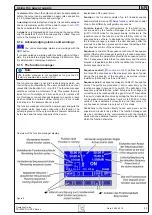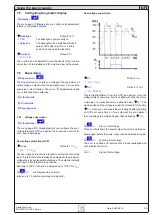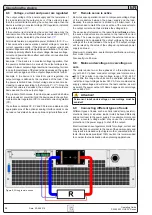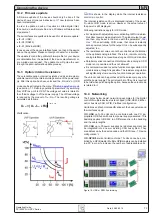
64
© 2006, Elektro-Automatik GmbH & Co. KG
Irrtümer und Änderungen vorbehalten
EN
Operating Guide
PSI 8000 3U HS PV Series
Date: 20-05-2016
Operating the device
Figure 9. Wiring remote sense
8.6 Voltage, current and power are regulated
The output voltage of the power supply and the resistance of
the load determine the output current. If this current is lower
than the current limitation set by the current set value, then the
device is working in constant voltage (CV) regulation, indicated
by the status text „
CV
“.
If the output current is limited by the current set value or by the
nominal current, the device will change to constant current (CC)
regulation mode, indicated by the status text „
CC
“.
All models feature an adjustable power limitation for 0...P
Nom
.
It becomes active and overrides constant voltage or constant
current regulation mode, if the product of actual current and
actual voltage exceeds the adjusted power limitation. The power
limitation primarily affects the output voltage. Because voltage,
current and power limitation affect each other, various situations
like these may occur:
Example 1: the device is in constant voltage regulation, then
the power is limited down. As a result, the output voltage is de-
creased. A lower output voltage results in a lower output current.
In case the resistance of the load is then decreased, the output
current will rise again and the output voltage will sink further.
Example 2: the device is in constant current regulation, the
output voltage is defined by the resistance of the load. Then
the power is limited down. Output voltage and current are de-
creasing to values according to the formula P = U * I. Once the
current set value is decreased, the output current would also
decrease and thus the output voltage.
The product of both values, the actual power, would sink below
the previously set power limit and the device would change from
constant power regulation (CP) to constant current regulation
(CC).
Those three conditions CC, CV and CP are also indicated on the
appropriate pins of the optional, analog interface cards or can
be read out as status bits via an optional, digital interface card.
8.7 Remote sense is active
Remote sense operation is used to compensate voltage drops
of the conductors between the power supply and the load.
Because the compensation is limited to a certain level, it is
recommended to match the cross section of the conductors to
the output current and thus minimise the voltage drop.
The sense input is located on the rear at terminal
Sense
, where
the sense conductors are connected to the load with correct
polarity. The power supply will detect the external sense au-
tomatically and compensate the output voltage by the actual
voltage at the load instead of the output. The output voltage
will be raised by the value of the voltage drop between power
supply and load.
Maximum compensation: see technical specifications, will vary
from model to model.
Also see figure 9 below.
8.8 Mains undervoltage or overvoltage oc-
curs
The units require two or three phases of a three-phase sup-
ply with 400 V phase conductor voltage and tolerate max.
+15%. This results in an input voltage range of 340...460 V
AC. Within this range, the units can be operated without any
restrictions. Input voltages below 340 V AC are considered as
supply undervoltage and will store the last condition, as well
as switch the power output off. Same happens at overvoltage
above 460 V AC.
Attention!
Permanent input undervoltage or overvoltage must be
avoided!
8.9 Connecting different types of loads
Different types of loads, such as ohmic loads (lamp, resistor),
electronic loads or inductive loads (motor) behave differently
and can retroact to the power supply. For example, motors can
induce a counter voltage which may cause the overvoltage
protection of the power supply to shut off the output.
Electronic loads have regulator circuits for voltage, current and
power that can counteract to the ones of the power supply and
may result in increased output ripple or other, unwanted side ef-
fects. Ohmic loads are almost 100% neutral. It is recommended
to consider the load situation when planning applications.













































